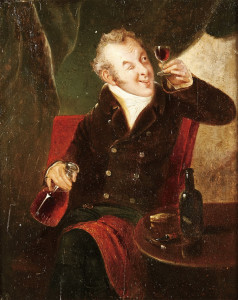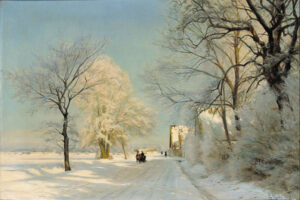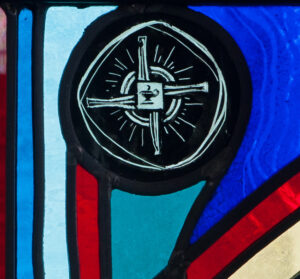Advent has run its course, Christmas has been made welcome, and now we enter into the Christmas season proper. When we sing the old carol about five golden rings and a partridge in a pear tree and all those other gifts that my true love gave to me, this is what we are singing about: The Twelve Days of Christmas begin now, now that Christmas Eve and Christmas Day have passed.
There are two approaches to the calculation of these Twelve Days: One approach has the Twelve Days of Christmas beginning on Christmas Day itself, while the other starts them on St. Stephen’s Day, the 26th of December. In this house, we subscribe to the second approach. Our ancestors, who perhaps were more attuned than we to the passing of the days and to each day’s meaning, loved symmetry in numbers, and the second approach provides exactly that. Christmas Day itself has long been seen as a day outside ordinary time: a most distinct and holy day, followed by a beautiful symmetry that comes along with the passing of the year. In this model, we have six days of Christmas in the old year and six days in the new, creating a balanced bridge at the start and end of each year, a balance that links the other old story –– that of the ever expanding round of the year as this old earth spins on its axis and rotates around the sun –– to the story of the child’s birth at Bethlehem. The links connect Christmas through the years in a lovely balance. More mystery, of the universal sort, heavenly yet here on earth.
If you feel let down when Christmas Day has passed, join us on our journey and you won’t have any reason to feel this way, and I do hope you’ll join us at your home in celebrating the full season that lasts through Epiphany on the Sixth of January. And if you are a bit in love with Christmas as we are in this household, welcome. Our Christmas tree and other greenery will be illuminated tonight and every night through Epiphany, and most likely we will go even beyond, for traditionally the greenery would come down at Candlemas Eve: the First of February. Keeping it up longer would invite goblins into your home, and no one wants that. But to bring light and cheer through all the dark month of January is, I think, a wonderful thing.
My plan this year for the Twelve Days of Christmas is to write a few Book of Days chapters, grouping together the days of Christmas that seem fittingly grouped, and in this chapter, we’ll discuss the first Two Days of Christmas. Before we begin, I’ve got a worthy suggestion: there are a few farm stand and pantry items you may find handy to stock up on for this season. My recommendations: apples, chestnuts, mulling spices, honey, red wine, fresh cider, and rose water. We can supply your mulling spices and rose water; ours are both made by the Sabbathday Lake Shakers and we’ll ship via US Priority Mail to get your domestic order to you in just two or three days.
And now to begin our journey: It begins, of course, with Christmas Day, December 25, a day outside ordinary time. In our model, Christmas Day stands alone in its holiness, a holyday/holiday if ever there was one. But December 26 brings St. Stephen’s Day and the First Day of Christmas:
FIRST DAY of CHRISTMAS
December 26
St. Stephen’s Day, Boxing Day, Day of the Wren, First Day of Kwanzaa
On this First Day of Christmas, Father Christmas brings Boxing Day, celebrated in England and the Commonwealth countries. Servants typically had to work on Christmas Day, but this First Day of Christmas was their day to spend with their families. Their employers would send them home with boxes of gifts for themselves and for the families they were heading home to. Perhaps more important, though, it is St. Stephen’s Day. Stephen was the first Christian martyr, and so the Church assigned this first day of Christmas to him. In Italy, this Giorno di Santo Stefano is a big deal. Christmas Eve and Christmas Day is for family, but St. Stephen’s Day is a day to bundle up and go out to visit friends and to visit nativity scenes. It is a day for roasted chestnuts and mulled wine (as is tomorrow, St. John’s Day: the Second Day of Christmas). My grandmother, Assunta, typically made soup for supper on this First Day of Christmas, when we remember Santo Stefano. The soup was a nice break from the rich fare of Christmas Eve and Christmas Day. Over in Ireland, it is the Day of the Wren. It is the wren that is traditionally thought to have brought bad luck upon the imprisoned Stephen, who was making his escape when a wren alerted the sleeping guards to the situation. His capture lead to his execution and martyrdom. Wrens were traditionally hunted on this First Day of Christmas, then paraded around town. Nowadays, the wrens paraded around town are effigies, and not real wrens (all is forgiven, wrens!).
The 26th also brings the start of a newer tradition, the First Day of Kwanzaa, which brings yet more light to the world through candles and a celebration of African-American culture: each candle and each day, through the First of January, focusing on one of seven principles: first, umoja (unity); then kujichagulia (self-determination); next, ujima (collective work and responsibility); followed by ujamaa (cooperative economics); and then nia (purpose); kuumba (creativity); and finally imani (faith).
SECOND DAY OF CHRISTMAS
December 27
St. John’s Day
On St. John’s Day we remember St. John the Evangelist, one of the Twelve Apostles and the only one who did not die a martyr’s death for his beliefs, although many attempts were made on his life. In the most famous of these, St. John was sentenced to die by ingesting poisoned wine. John drank the wine but the poison had no effect on him. And so it is customary on this Second Day of Christmas to give gifts of wine, as well as to bring bottles of wine to church to be blessed, especially in Germany and Austria. This blessed St. John’s wine is thought to have healing properties and to taste better than other wines. Some even hold that wine that is not blessed but is stored nearby to blessed St. John’s wine improves in flavor just by being near it. It is a fine night (as are most nights during Christmastide) to enjoy mulled wine and roasted chestnuts… and here is our recipe for mulled wine, one of the loveliest drinks of the Yuletide season (indeed, all winter long):
M U L L E D W I N E
A bottle of good red wine
Mulling spices (a blend of cinnamon, cloves, allspice, orange peel)
Sugar
Pour a quantity (enough for as many people as you are serving) of good red wine into a stainless steel or enamel pot and set it on the stove over medium heat. Add about a teaspoon of mulling spices for each serving. Add sugar: start with a teaspoon or two of sugar and add more to taste. We prefer a less-sweet mulled wine, and while you can always add more sugar, you can’t take it away once it’s in. So my recommendation is to add the sugar gradually, tasting as you go. Heat to allow the spicy flavors to infuse the wine, but do not allow to boil. Strain before serving in cups (not glasses).
I’ll be back with our next chapter on the Third Day of Christmas: Childremas, or Holy Innocents’ Day… it is a day in the Twelve when the story takes a dark turn, acknowledging the sorrows in life. For now, though: Cheers!
TWELVE DAYS of CHRISTMAS SALE
At our online shop, our Twelve Days of Christmas Sale brings you automatic markdowns on most of our authentic German handmade nutcrackers, pyramids, and incense smokers. We are running the sale for the full Twelve Days of Christmas, through the Sixth Day of January. If there are things you wanted that Santa couldn’t fit in his sleigh, well, we’re here to help (and to offer you our best prices of the year, too). CLICK HERE to shop!
Image: “Provando o Vinho” (“Tasting the Wine”) by an unknown artist working in the English School, Portugal. Oil painting, 19th century. [Public domain] via Wikimedia Commons.


